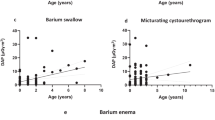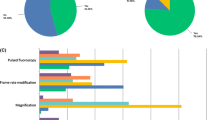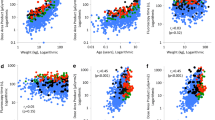Abstract
Background
Fluoroscopy is an important tool for diagnosis in the pediatric population, but it carries the risk of radiation exposure. Because radiology resident education and experience in the use of fluoroscopy equipment in children vary, we implemented an intervention to standardize fluoroscopy training.
Objective
The purpose of this study is to determine the impact of implementing a fluoroscopy competency check-off for radiology resident trainees aimed at decreasing radiation exposure in three common pediatric fluoroscopic studies.
Materials and methods
A fluoroscopy competency check-off form was developed for radiology resident trainees performing pediatric procedures. Techniques used to limit radiation exposure for common pediatric radiologic studies were reviewed as part of the check-off process. Pediatric radiologists supervised each trainee until they demonstrated competence to independently perform three specified procedures. Radiation dose was recorded for the three procedures, upper GI (UGI), voiding cystourethrogram (VCUG) and oropharyngeal (OPM) exams, over 6 months preceding and 6 months following implementation of the competency check-off. The mean cumulative dose for each procedure was compared before and after implementation of competency check-off using a Kruskal-Wallis test.
Results
During the 12-month study period doses from 909 fluoroscopic procedures were recorded. In the 6 months preceding competency check-off implementation, procedures were performed by 24 radiology resident trainees including 171 UGI, 176 VCUG and 171 OPM exams. In the 6 months following competency check-off, 23 trainees performed 114 UGI, 145 VCUG and 132 OPM exams. After competency check-off implementation, a statistically significant reduction in average radiation dose was found for all three studies (P < 0.001). Median cumulative doses (mGy) were decreased by 33%, 36% and 13% for UGIs, VCUGs and OPMs, respectively.
Conclusion
Implementation of a competency check-off for radiology resident trainees can reduce average radiation doses in pediatric patients undergoing three common fluoroscopic studies.




Similar content being viewed by others
References
Sheyn DD, Racadio JM, Ying J et al (2008) Efficacy of a radiation safety education initiative in reducing radiation exposure in the pediatric IR suite. Pediatr Radiol 38:669–674
Xu BJ, Duszak R Jr, McGinnis RS et al (2013) Increased fluoroscopy time for central venous catheter placement by radiology residents versus staff radiologists. J Am Coll Radiol 10:518–522
Cohen BL (2002) Cancer risk from low-level radiation. AJR Am J Roentgenol 179:1137–1143
Haaga JR (2001) Radiation dose management: weighing risk versus benefit. AJR Am J Roentgenol 177:289–291
Brenner D, Elliston C, Hall E et al (2001) Estimated risks of radiation-induced fatal cancer from pediatric CT. AJR Am J Roentgenol 176:289–296
Goske MJ, Applegate KE, Boylan J et al (2008) The Image Gently campaign: working together to change practice. AJR Am J Roentgenol 190:273–274
Connolly B, Racadio J, Towbin R (2006) Practice of ALARA in the pediatric interventional suite. Pediatr Radiol 36:163–167
Donnelly LF (2005) Reducing radiation dose associated with pediatric CT by decreasing unnecessary examinations. AJR Am J Roentgenol 184:655–657
Strauss KJ, Kaste SC (2006) The ALARA concept in pediatric interventional and fluoroscopic imaging: striving to keep radiation doses as low as possible during fluoroscopy of pediatric patients–a white paper executive summary. AJR Am J Roentgenol 187:818–819
Strauss KJ, Kaste SC (2006) The ALARA (as low as reasonably achievable) concept in pediatric interventional and fluoroscopic imaging: striving to keep radiation doses as low as possible during fluoroscopy of pediatric patients–a white paper executive summary. Radiology 240:621–622
American College of Radiology, RSNA, American Society of Radiologic Technologists, American Association of Physicists in Medicine (2010) Image Wisely. American College of Radiology, Reston
Brink JA, Amis ES Jr (2010) Image Wisely: a campaign to increase awareness about adult radiation protection. Radiology 257:601–602
Goske MJ, Applegate KE, Boylan J et al (2008) The ‘Image Gently’ campaign: increasing CT radiation dose awareness through a national education and awareness program. Pediatr Radiol 38:265–269
Jafari ME, Daus AM (2013) Applying Image Gently SM and Image Wisely SM in nuclear medicine. Health Phys 104:S31–36
Gaca AM, Frush DP, Hohenhaus SM et al (2007) Enhancing pediatric safety: using simulation to assess radiology resident preparedness for anaphylaxis from intravenous contrast media. Radiology 245:236–244
Hoskins PR, Williams JR (1992) Influence of radiologist grade on fluoroscopic patient dose. Br J Radiol 65:1119–1123
Mahesh M (2001) Fluoroscopy: patient radiation exposure issues. Radiographics 21:1033–1045
Nasca TJ, Philibert I, Brigham T et al (2012) The next GME accreditation system–rationale and benefits. N Eng J Med 366:1051–1056
Miller GE (1990) The assessment of clinical skills/competence/performance. Acad Med 65:S63–67
Warm EJ, Mathis BR, Held JD et al (2014) Entrustment and mapping of observable practice activities for resident assessment. J Gen Intern Med [Epub ahead of print]. doi:10.1007/s11606-014-2801-5
Archer BR, Wagner LK (2000) Protecting patients by training physicians in fluoroscopic radiation management. J Appl Clin Med Phys 1:32–37
Administration USFaD (2002) 21CFR1020.32, Part 1020 - Performance standards for ionizing radiation emitting products. Code of Federal Regulations. United States Department of Health and Human Services, Silver Springs, MD
Jones AK, Pasciak AS (2011) Calculating the peak skin dose resulting from fluoroscopically guided interventions. Part I: Methods. J Appl Clin Med Phys 12:3670
Vehmas T (2003) Do radiologists’ radiation-related opinions predict their fluoroscopy doses? Br J Radiol 76:653–655
Ward VL (2006) Patient dose reduction during voiding cystourethrography. Pediatr Radiol 36:168–172
Brateman L (1999) Radiation safety considerations for diagnostic radiology personnel. Radiographics 19:1037–1055
Agrawalla S, Pearce R, Goodman TR (2004) How to perform the perfect voiding cystourethrogram. Pediatr Radiol 34:114–119
Lim R, Khawaja RD, Nimkin K et al (2013) Relationship between radiologist training level and fluoroscopy time for voiding cystourethrography. AJR Am J Roentgenol 200:645–651
Oztas E, Parlak E, Kucukay F et al (2012) The impact of endoscopic retrograde cholangiopancreatography education on radiation exposure to experienced endoscopist: ‘trainee effect’. Dig Dis Sci 57:1134–1143
Uradomo LT, Lustberg ME, Darwin PE (2006) Effect of physician training on fluoroscopy time during ERCP. Dig Dis Sci 51:909–914
Zhou Y, Singh N, Abdi S et al (2005) Fluoroscopy radiation safety for spine interventional pain procedures in university teaching hospitals. Pain Physician 8:49–53
Conflicts of interest
None
Author information
Authors and Affiliations
Corresponding author
Rights and permissions
About this article
Cite this article
Shah, S., Desouches, S.L., Lowe, L.H. et al. Implementation of a competency check-off in diagnostic fluoroscopy for radiology trainees: impact on reducing radiation for three common fluoroscopic exams in children. Pediatr Radiol 45, 228–234 (2015). https://doi.org/10.1007/s00247-014-3108-8
Received:
Revised:
Accepted:
Published:
Issue Date:
DOI: https://doi.org/10.1007/s00247-014-3108-8




